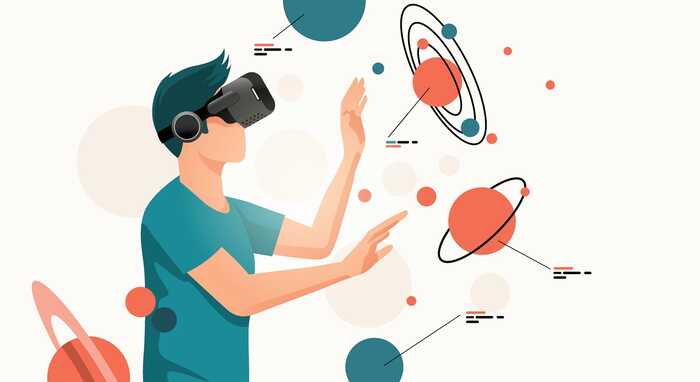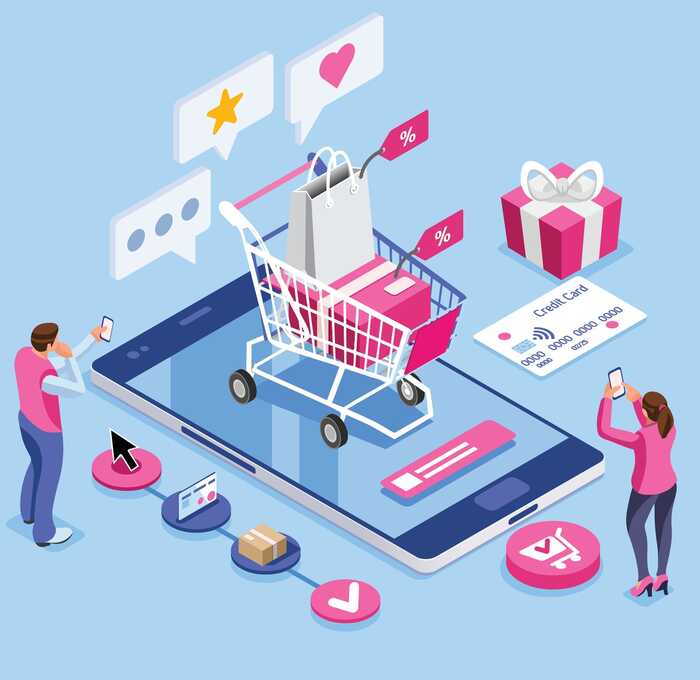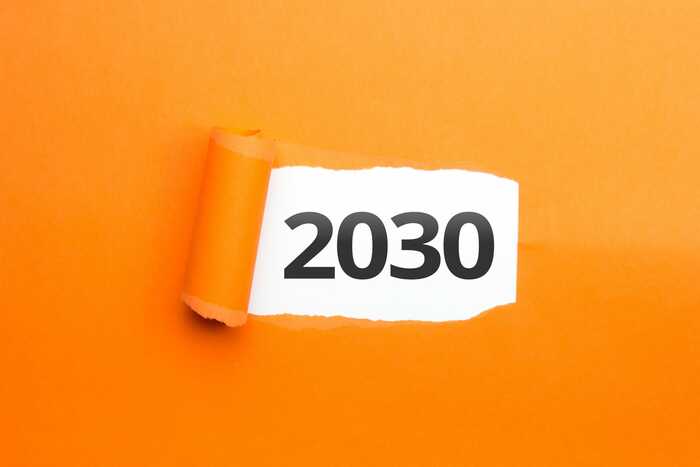10 Predictions for Digital Marketing in the Next 10 years
The future’s here, kids.

Our 10th Birthday
Our Predictions
Join us as we cast our eyes across the dimensions of time and space, and try to predict how the digital marketing landscape might change over the next decade.

Snackable content
This probably won’t shock you. The explosive pace at which the information age has evolved over the last decade has narrowed our attention spans. A 2019 study by the Technical University of Denmark revealed that the global population’s ability to focus its attention on content has dwindled—due to the sheer amount of information that we’re exposed to.
With the emergence of short video-sharing apps like Instagram, TikTok and, for a while at least, Vine, there’s been a dramatic shift in the way consumers absorb content. Short, snappy, snackable chunks of media is what sticks for people these days. With the relative tsunami of material that’s available to us on a daily basis, marketers have to be cunning in their methods of occupying some of that precious digital space.
The big question, of course, is what happens when user attention span is reduced further still?
Micro-storytelling in adverts could be one suggestion; ultra-streamlined narratives that invite customer engagement. 2020 saw a wave of global brands utilizing YouTube as a platform for this emerging paradigm. Expect more to follow.
The world has become more internet savvy
With 96% of the UK population alone having access to the internet at home—with 400,000 of them now hooked up with full fibre broadband—it’s clear that the online experience is not the intimidating, uncertain landscape it might once have been for the consumer. People are using the internet for, well, just about everything. Social media, banking, shopping, education, work; many of the key strands of our lives have become profoundly reliant on a stable internet connection.
For retail, the numbers continue to grow. Online shopping is now the norm for a huge percentage of consumers—and it’s reaching some surprising demographics. 2019 marked the first year in which over half (54%) of the UK’s 65+ age group reported making an online purchase within the last 12 months.
In response, businesses will need to adapt their marketing strategies to incorporate this wide and varied customer base.
Older audiences have a tendency to rank customer service, personal contact and traditional communication above all else. If they get the sense of receiving that feeling of individual customer care within an online environment, they are compelled to share it and, importantly, look for ways to repeat the experience.

Shopping
As the traditional shopping experience becomes more sophisticated—with the development of apps that compare prices using product images, loyalty apps without physical cards, in-app discounts usable inside of stores—the onus is now on businesses to harness the power of new technology to meet the more discerning customer’s needs.
The future is augmented reality.
Innovative AR solutions give consumers the chance to visualise products in real-time, from the comfort of their own homes.
Full 3D visualisations allow shoppers to see how products might look in their environment before they make a physical purchase, thus reducing the need to order multiple items to try out, before choosing one and returning the others.
Augmented reality can streamline the process, reduce returns, and enhance the customer experience.
Speed
If there’s one trend that refuses to quit in the world of digital marketing, it’s the customers’ desire for one thing: speed. As devices get more responsive and lightning-quick fibre-optic broadband becomes the norm in the next decade, so will the user’s expectancy of instant results increase.
Customers want webpages to load in a microsecond, chatbot responses to be immediate, and parcels on their doorstep yesterday. It’s all about speed.
For businesses, the challenge is to keep up. To meet customer expectations, and make the pace of their operation as slick as possible, firms will need to lean more on automation for manual processes like ad buying and email campaigns.
In the next decade, companies will rely more on versatile, multi-purpose software such as Keap to give them a unique advantage in their marketing strategies. Businesses can use agile CRM to create rules-based visual maps of their client-consumer interactions.
Device types
In the last decade, businesses have been required to become nimble-footed in their response to the constant evolution of hardware. From laptops to phones, to tablets—and now phablets and phones with folding screens—there’s no company that hasn’t had to adapt their websites and marketing strategies to coordinate with their customers’ device habits.
Just as we’re getting used to the idea of the entire population having a smartphone—it’s 79% of adults in the UK—or a tablet—users have doubled worldwide in the last 8 years to 1.3bn—businesses will now have to shift gears again as new technology becomes more popular in the future.
While wearable technology is unlikely to replace smartphones anytime soon, the endless possibilities of marketing through sophisticated gadgets will give businesses pause for thought.
From smartwatches and smart wristbands to biomechanics shirts that record fitness information in 3D, the amount of touchpoints businesses will have to connect with their customer base is forever growing and evolving. A study from early-2020 discovered that the percentage of smartwatch/fitness wearables had nearly doubled in the UK from the previous 12 months to 12%—although, interestingly, the same study suggested that 32% of all wearable devices stopped being used within the first month of acquiring them.
Businesses with a dynamic approach to marketing will continue to create new and innovative strategies to match the times.
Voice assistants
The idea that someone’s entire life could be coordinated by a highly-sophisticated, softly-spoken voice assistant is no longer just the brainchild of your favourite science-fiction writer. It’s now become a reality. We have them in our homes, our offices, our cars and even our trouser pockets. Ready to open the blinds, change the mood lighting, play our favourite music, or take notes from a meeting.
It’s not been entirely smooth sailing, of course. There were a few stumbling blocks for machine intelligence companies who work with the likes of Google and Amazon for their respective voice assistant software. Strong regional dialects were often difficult to interpret—particularly thick Irish or Scottish accents—something that was ironed out with thousands upon thousands of hours of human testing and correcting. The OK Google voice assistant also had a tendency to fire up its engines each time anyone uttered the word okay—which, it turns out, is quite often.
Despite its troubled origin story, it’s clear that voice assistants will become an even bigger engagement touchpoint for customers in 2021. It’s projected that by the end of next year, there will be over 1.6 billion people who regularly use voice assistants software—and its tasks will become much more complex than simply opening and reading an email or logging into your Netflix account.
The future will involve brands enhancing and improving the integration of voice technology into their marketing strategies. Today, voice shopping is valued at £1.5bn, and it will hit nearly £30bn by 2022. Global brands like Domino’s and Nestlé are already exploring the possibilities of connecting with their customers through this ever-evolving technology. Expect more companies to follow this trend.
Social media
2020 saw a continuing trend of brands harnessing the potential of video and interactive content on social media to stand out in the overcrowded digital marketspace.
To drill down further, there’s been a keen focus on the idea of brand authenticity; adopting a friendly, human persona on their social channels with an express intent of attracting a community of loyal, engaged followers. We’ve all seen huge multinational brands embroil themselves in hot Twitter beef over the last 12 months—a supermarket chain can go viral in minutes if they craft the right response to a customer complaint or throw shade over a rival company. Just like Pinnochio, faceless big-ticket firms want to become a real boy. A relatable, human contact point that users can feel they can interact with on social media.
In the words of social media strategy consultant Neal Schaffer:
“If your business wants to survive in organic social media in 2020,
I believe that this sort of humanization of your brand will be necessary.”
Where next for social media and digital marketing?
Well, according to Facebook, due to the saturation of daily content on its platform, it’s becoming a lot more discerning about what it drops on its users’ feeds. The social media behemoth has realigned its focus to consumer-relevant content. Clearly, Facebook has evolved into a paid advertising and marketing platform—and, as time goes on, we’ll likely see that transition even more marked.

AI getting smarter
I’m sorry to be the one to inform you: the robots are here to stay. 2020 might just be the year that the world finally lets AI (artificial intelligence) into their homes and businesses without an underlying sense of unease and suspicion.
In the world of digital marketing, AI can already study consumer behaviour and search patterns. It can collect and analyze data from social media platforms and help firms understand how customers find their products and services.
As the machines get smarter, the scope and prevalence to which AI will be implemented into global business and industry will only increase. While they can already undertake a litany of simple tasks currently, who knows how far artificial intelligence will take us in the future. Hopefully not to an end-of-the-world, Skynet situation, but I’m afraid I don’t make the rules.
I, for one, welcome our new robot overlords.
The smart money is on the refinement and increased intelligence of chatbots. Chatbot programs can be used to connect to customers and answer any query or question they might be sitting on. The very best of them can engage in spookily articulate, human-like conversations. As the chatbots get smarter, so will the customer experience and the efficiency of problem-solving improve.
Loss of Trust
While businesses become increasingly more reliant on advanced technology to engage with their customer base, with it comes the unavoidable challenge of creating a climate of trust. There’s no debating that artificial intelligence and voice assistant software can enhance the user experience; but at what cost? How can businesses convince customers that the personal data they might be surrendering is being used for legitimate purposes; that the voice assistant listening to your every whim and command isn’t sharing conversations with market researchers?
In 2018, Mark Zuckerberg threw himself in front of the world’s media with the aim of rebuilding consumer trust in his billion-dollar social media platform, Facebook.
As well as batting away questions about his lack of transparency concerning the Russian infiltration of Facebook, he was also asked about his company’s practices with user data. Namely, how Facebook used personal information to shape the content of users’ news feed.
With the foundations of trust already shaken, it’s clear that businesses will have to offer more transparency to their customers in the next decade if they want to develop and utilize advancing, often intrusive technology in their digital marketing strategies. Firms may need to lift the curtain on exactly how the technology is implemented and how customer data is used.
For those businesses that are transparent and do communicate openly with customers, the reward is loyalty with 94% of consumers saying that they would stick with a company that offers transparency and 73% would be open to pay more for a product that offers it.
Increased Restrictions
Customers’ demands can be quite simple. Often all they’re searching for is transparency, choice, and control over how their data is used. With that in mind, it’s clear the online ecosystem must evolve to tackle these demands.
With the recent binning of third-party cookies, businesses must rethink their data collection strategies and instead seek out new ways to personalize customer preferences. Doing so will create an environment of trust between companies and their clients, while still being able to provide the control and personalization consumers still desire.
For digital marketers, it’s vital to think about privacy and building trust with their audience. Create a platform in which insights and analytics can be monitored, but put the user firmly in control.
With these increased restrictions, and perhaps more measures to follow in the next decade, it’s fundamental for digital marketers to inspire confidence, while at the same time creating new, innovative strategies to enhance the customer experience.

And finally…
So, there we have it—our (hopefully) helpful guide for the digital marketing trends to look out for in the next ten years.
As Albert Einstein once said: “The measure of intelligence is the ability to change.”
For those of us in digital marketing, change is a fundamental part of the job. We must constantly look to the future and be encouraged to embrace new technology and strategies to keep ahead of the rapidly-flexing curve.
Other Relevant Resources
There's always more to learn, we recommend these blogs:
Posted on December 12th 2020




